In March 2020, COVID-19 was declared a global pandemic, leading to dynamic changes and hard measures, which impacted everyday life as we knew it. At that time, I was travelling on the other side of the world, rewarding myself after the successful completion of my doctoral studies. During my PhD, I studied immune responses to pulmonary infections. Certainly, some might see the irony, that my graduation trip was interrupted by a respiratory virus. In this article I want to share with you how I experienced the beginning of the pandemic on the other side of the globe, in Central America.
How the journey started
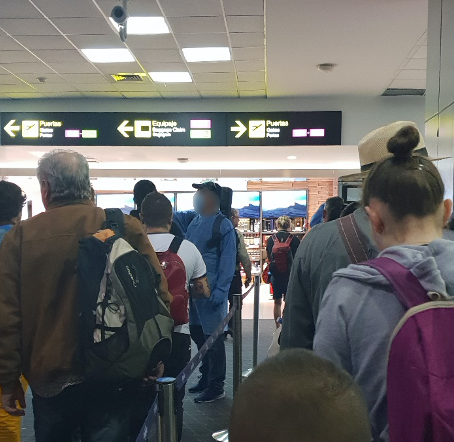
In early March I started my trip in Panama. Back then, travel restrictions only affected some countries – China, South Korea, Italy, and Japan. Of course, I was slightly nervous about travelling as no one exactly knew how fast the virus might continue to spread. A few people were wearing masks and gloves in transit zones or on airplanes, but that was certainly not the norm. Upon my arrival in Panama City, my temperature was checked before I was allowed to leave the plane. At that time, Panama had already recorded its first COVID-19 cases. I stayed in Panama just a couple of days and experienced the travel life as usual. No one was even thinking about social distancing at hotspots and sightseeing areas at that time.
How the situation changed quickly
After two days in Panama I was about to continue my trip to Costa Rica, when suddenly the Panamanian government announced a state of emergency and the imminent closure of their borders. Within days Panama had hard restrictions and curfews in place and these measures were strict compared to other Central American countries. For example, separate days of the week were assigned for men and women to go out for grocery shopping.
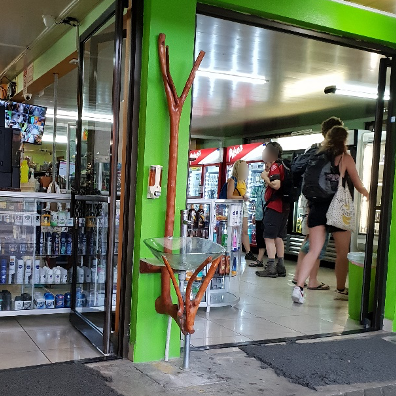
Arriving in Costa Rica, I took a shuttle bus to my destination. To my surprise, I was offered a big bottle of hand sanitiser by the bus driver to disinfect my hands before entering the vehicle. I wondered why shuttle busses in Costa Rica could provide disinfectant while Germany ran out of commercial hand sanitisers and disinfectant weeks even before the pandemic had begun (February 2020). The bus driver explained to me, that the government took precautions and asked the local alcohol producers to use cane sugar to produce disinfectants instead of spirits. In this way, every company was able to receive the amount of disinfectants they needed. This was in line with my general impression, that public places reacted to the changing situation quite early in the outbreak and increased their hygiene measures. Disinfectants were placed at the entry of all supermarkets and restaurants, some had even installed sinks for customers to wash their hands. In restaurants and cafés, waiters were carefully disinfecting tables, menus and sometimes even money.
The first few days in Costa Rica appeared to me quite ‘normal’; people were still going out to restaurants, grocery shops, and national parks. People on their holidays or spring break enjoyed their time in bars and clubs. However, more restrictions were implemented quite quickly, and soon all clubs and bars were closed. Restaurants were only allowed to operate with 50% of their capacity, and later on only offered take-away. Within a few days, the closure of the borders and national parks was announced in order to restrict tourist movement.
More stringent measures followed soon after and beaches and all public places were closed to avoid people travelling to seaside towns from more densely-populated areas. Locals were quite frustrated about this and some surfers still risked punishment to surf at remote beaches. At first, police officers were lenient to violation, but after two weeks they took drastic measures to get the surfers out of the water e.g. using their guns to chase away surfers.
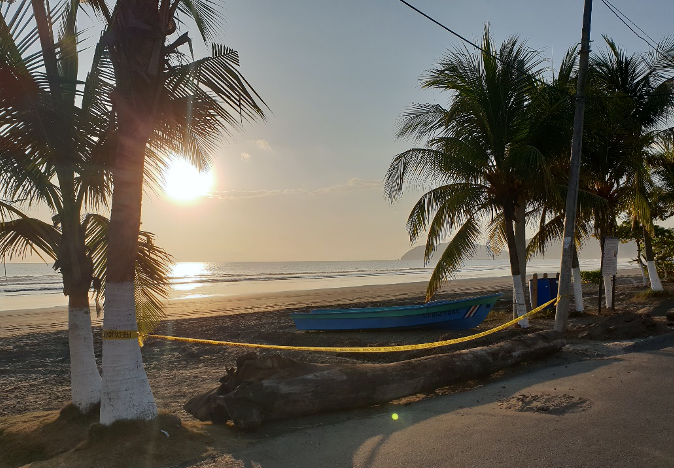
Closed beach. Image by A.S., © 2020.
How local people coped with the situation
Despite the uncertain situation, I found the people of Costa Rica quite helpful and friendly. Generally, I had the impression that Ticos (Costa Rican folks) were more ‘relaxed’ and handling the rapidly changing situation and the stress compared to other Western countries. During my stay I never saw panic buying or empty shelves in the supermarkets. The grocery stores even had full stocks of toilet paper all the time! When I talked to some locals, they explained to me that for them there was no reason to panic, their country had a lot of food to offer. If needed, they could go and get some fruits or rice close by, or go fishing. Indeed, Costa Rica produces and exports an abundance of pineapples, bananas, coffee, melons, sugar and seafood.

Full stock of toilet paper in the supermarket. Image by A.S., © 2020. 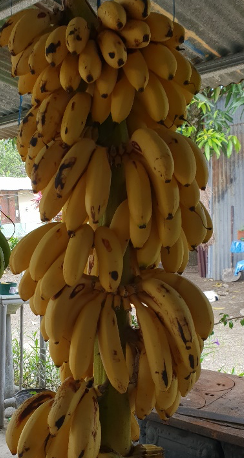
Bananas are everywhere. Image by A.S., © 2020. 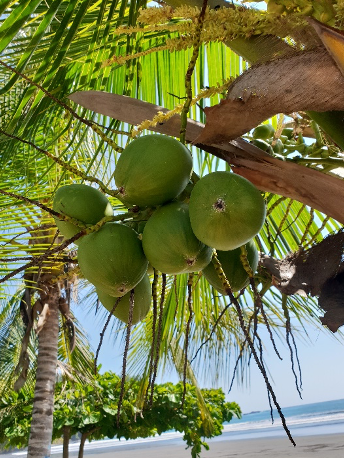
Coconuts are everywhere. Image by A.S., © 2020.
How the local economy depends on tourism
As for many other countries the consequences of the lockdown due to COVID-19 affected the tourism sector enormously. Costa Rica is a popular destination for eco-tourists as it offers one of the most beautiful and diverse flora and fauna. It also provides universal health care which is ranked by United Nations as one of the best in Latin America1. Therefore, it attracts many medical tourists from the United States due to the lower costs (compared to U.S.A. costs for certain medical procedures are 4-5 times lower). In 2016, tourism accounted for around 6 % of Costa Rican GDP and 28 % of total Costa Rican employment was linked directly and indirectly to tourism 2,3. Also, there are about 500,000 foreigners living in Costa Rica in total, out of a total population of 5 million people4. In order to ease the situation for tourists, the Costa Rican government extended most tourist visas for foreigners who were stuck in the country due to COVID-19. Because of the rapid decline of tourist numbers, many places became ghost towns and locals were shocked to see for the first time in their lives empty streets and beaches that are usually so full of life.
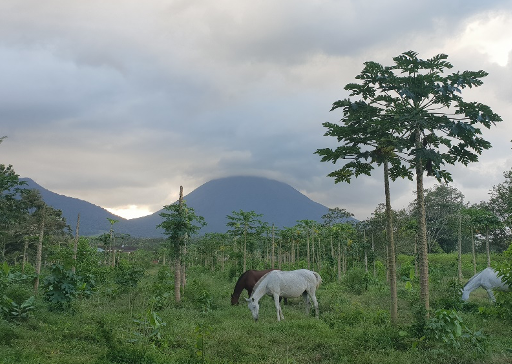
Arenal Volcano. Image by A.S., © 2020. 
Agalychnis callidryas. Image by A.S., © 2020. 
Flying scarlet macaw. Image by A.S., © 2020. 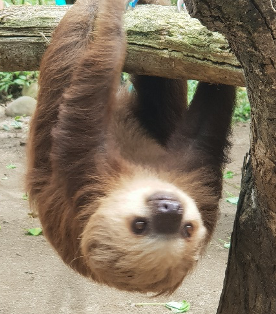
Sloth. Image by A.S., © 2020. 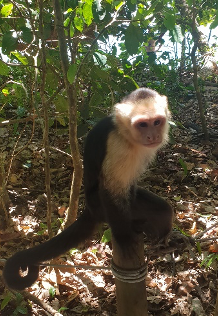
White-faced capuchin. Image by A.S., © 2020. 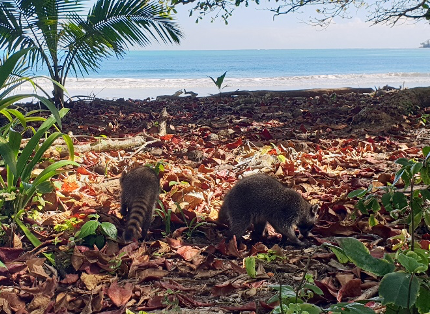
Raccons at the beach. Image by A.S., © 2020.
How to deal with the situation in a foreign country
Understandably, the atmosphere became more depressing for locals and tourists alike. Within a few days, most countries around the world had closed their borders and more flights were cancelled every minute. Due to this sudden new situation, no one knew exactly how to proceed, and travelers had to face the decision of whether to stay where they were, continue their travel, or go back home. The latter choice was a bit of a nightmare. If you were lucky enough to get a seat on a flight home, which was not directly cancelled after the booking, it was probably overpriced and included 15+ hours stopover in an overcrowded transit airport (e.g. New York) – not very attractive given the circumstances. And even then, it wasn’t guaranteed you could board your connecting flight, as some people weren’t allowed to switch terminals and became stuck in the transit zones.
As the epicenter of the pandemic was Europe by then, some Europeans decided to stay in Costa Rica and see how the situation developed with time. Others left to other countries – such as Mexico or Nicaragua, which hadn’t implemented COVID-19 measures that would prevent them from continuing their holiday. However, this turned out to be quite risky because the situation became more unpleasant for tourists in some areas of Latin America. Soon, some tourists began to feel unwelcome and blamed by locals for bringing the virus into their country.
The situation was quite chaotic and stressful. I was never much afraid that the situation could escalate in Costa Rica because local people always appeared calm and patient but following the news around the world and receiving worried calls from family members and friends back home made me sometimes quite anxious. I booked a flight back home, which was directly cancelled after the booking. I decided to stay calm and see how the situation developed. I tried to make the best of my situation – I read a few books, talked to the locals and got to know their culture and their lives, I talked to foreigners who shared the same fate as me, and listened to their stories.
How I got back home
As many tens of thousands of Germans were stuck in Costa Rica, the German government organised rescue flights. To give you a little insight on how the recue flights were arranged for German citizens: After registration at the site of rueckholprogramm.de, they were contacted by the German Embassy via telephone and told when their flight was leaving. Some people had been called on the same day as the flight departure, so they needed to pack quickly and organize their way to the airport. They had to arrive at the airport at least 4 hours before departure and sign declarations that they were not showing any COVID-19 symptoms and that they would bear all (yet to be determined) costs for the flight. Other EU citizens were also able to take these flights. Later, I found out that the aircraft staff had volunteered for these flights. Families with children, elderly or immunocompromised people were of course given the priority for these flights.
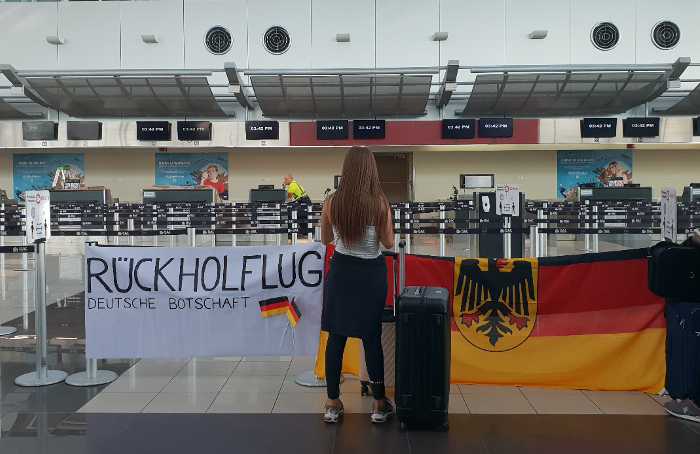
Rescue flight organized by the German embassy at Juan Santamaria International Airport. Image by A.S., © 2020.
I left Costa Rica on the last rescue flight going to Germany with the memories of quite an extraordinary and an extreme time for me – Being alone in a country I hadn’t been before, not knowing anyone and in times of global fear and uncertainty, I experienced an incredible amount of help, support and solidarity from people of different nationalities. Certainly, the pandemic led to changes of everyone’s lives – but the solidarity and all kindness and selflessness I have experienced gives hope for a much better society after this crisis is over.
Pura Vida!
Author: A.S.
References
1 Tandon, A., Murray, C. J., Lauer, J. A., & Evans, D. B. (2000). Measuring overall health system performance for 191 countries. Geneva: World Health Organization.
2 OECD (2018), OECD Tourism Trends and Policies 2018, OECD Publishing, Paris.
3 Alvarado, L. Tourism represents 5.8% of GDP in Costa Rica. The Costa Rica Star.
4 https://costaricalaw.com/costa-rica-legal-topics/immigration-and-residency/how-many-foreigners-live-in-costa-rica/ (accessed on July 30, 2020).
